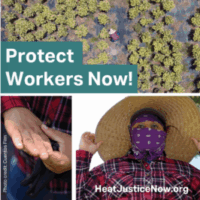This Workers Memorial Day, NELP urges OSHA to ensure employers keep workers safe on the job
Washington, DC—Despite promises by the Trump administration to hire more federal workplace safety inspectors, the number of inspectors in the Occupation Safety and Health Administration (OSHA) has fallen to a 45-year low, according to a new report published today by the National Employment Law Project.
Data obtained by NELP through the Freedom of Information Act reveal that federal OSHA had only 862 inspectors as of January 1 to cover millions of workplaces. That’s down from 952 inspectors in 2016 and 1,006 inspectors in 2012. At current staffing levels, the agency would need 165 years to inspect each workplace under its jurisdiction just once, according to NELP.
READ THE REPORT: Worker Safety in Crisis: The Cost of a Weakened OSHA
“OSHA’s mission to protect workers in the most dangerous jobs has been seriously compromised under the Trump administration,” said Debbie Berkowitz, NELP’s worker safety and health program director and a former senior OSHA official. “The agency has essentially abandoned its responsibility to ensure that employers keep workers safe from COVID-19.”
The continued decline in the ranks of inspectors comes as OSHA has been flooded with some 2,400 coronavirus-related complaints since February, and as major outbreaks have hit meatpacking plants and other places of work. Thus far, the agency has resisted calls to issue any protective mandates or to enforce the protective guidance published by the Centers for Disease Control and Prevention.
More than 16,000 workers have already fallen ill, and hundreds have died from COVID-19, including workers in hospitals, first response, nursing homes, meat and poultry plants, warehouses, grocery stores, and mass transit. The workers in many of these critical industries are disproportionately workers of color.
Workers of color are particularly affected by OSHA’s failure to protect workers in the most hazardous jobs, as Black and Latinx workers, many of whom are immigrants, disproportionately work in those jobs and suffer higher fatality rates than other workers. In its latest release, the Bureau of Labor Statistics found that the number of Black workers killed on the job in 2018 rose 16 percent, from 530 to 615, the highest total since 1999.
“NELP is releasing this report today—Workers Memorial Day—because we will not forget the workers who’ve lost their lives or been hurt or made sick on the job, or the workers forced to organize for their own health and safety due to the negligence of employers and OSHA. This fight has taken on the greatest urgency during this COVID-19 pandemic, with disproportionate illness and loss of Black and Latinx workers due to systemic failures that must be solved,” said Rebecca Dixon, executive director of NELP.
“We mourn those we have lost, but we renew our collective commitment to fight alongside all the worker activists and unions who organize to demand safer conditions for all workers,” continued Dixon. “We commend the unions that are demanding safer conditions for health care, supermarket, sanitation, and transportation workers. And we applaud the meat and poultry workers who walked off the job because they feared for their safety during this pandemic; the Amazon workers who let the public know about the lack of protections against COVID-19 in the warehouses; and the Instacart workers who held a one-day walkout to demand safety conditions,” said Dixon.
New data in NELP’s new report show the following:
- OSHA has failed to fill 42 percent of its top leadership career positions, leaving the agency without requisite expertise and direction to protect workers.
- The number of OSHA inspections per year under the Trump administration is more than 5,000 inspections less per year than the average number of inspections under the Obama[i] or Bush administrations.
- OSHA has reduced the number of complex, time-intensive investigations. There has been a 25 percent drop in heat-related inspections; a 66 percent drop in inspections related to musculoskeletal injuries; a 27 percent drop in inspections where OSHA measures workers’ chemical exposures; and a 38 percent drop in the highest penalty “significant cases.”
- OSHA has reduced the deterrent impact of OSHA inspections by only publicizing a handful of its inspection results, drastically reducing the number of enforcement press releases issued by the agency by more than 50 percent from the previous administration. Although OSHA conducted more than 12,000 inspections in the second half of 2019, the agency only issued 84 press releases about violations cited. During the last six months of 2016, for example, OSHA issued 214 such releases.
- Mandatory federal OSHA inspections opened as a result of a workplace fatality or catastrophe have increased during the Trump administration to the highest levels in over a decade.
READ THE REPORT:
Worker Safety in Crisis: The Cost of a Weakened OSHA
Endnotes
[i] One year during the Obama Administration, 2016, was an outlier and thus reduced the totals for those years, because OSHA changed the way it counted and measure enforcement activity that year. Inspectors were tasked with conducting longer and more complicated inspections, and thus the total number of inspections fell as inspectors spent more time on complicated inspections. However, in the following three years under this administration, FY 2017-19, OSHA did less of the complicated inspections, but the total number inspections did not bounce back to previous levels.



